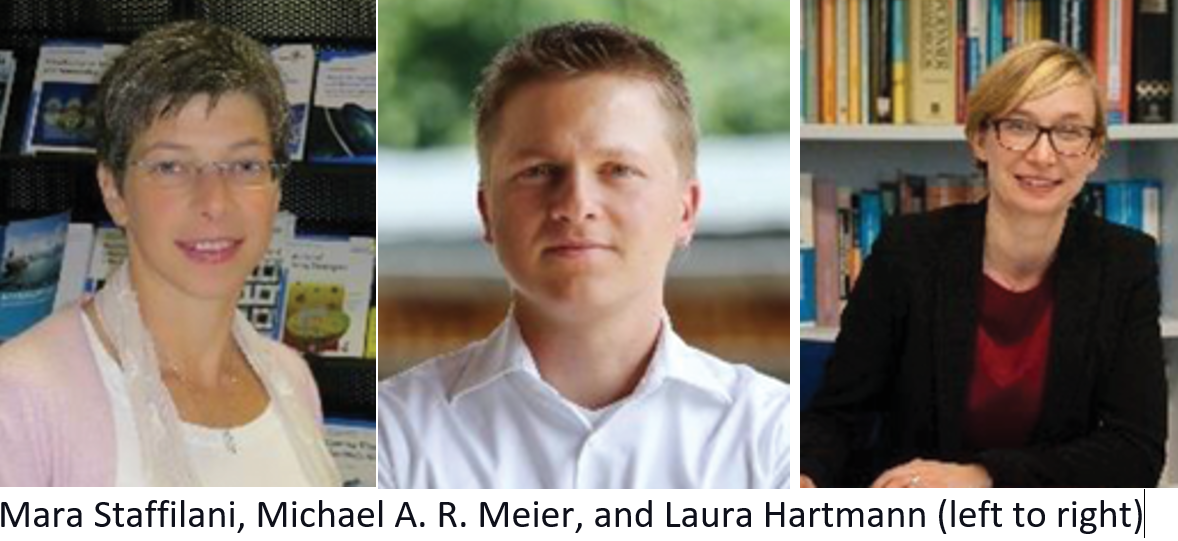The journal Macromolecular Chemistry and Physics has just published the perspective article “The next 100 years of polymer science”. The article is special not only because it gives a broad overview of the field, but also due to the way it was written. The idea was born during a dinner at the Macromolecular Colloquium in Freiburg, Germany, in February 2020 by Laura Hartmann, Michael A. R. Meier, and Mara Staffilani.
The three of them managed to gather the views and opinions of 54 authors from 14 countries, the entire editorial board of the journal, and put everything into an easily readable form. The article contains many quotations from all authors reflecting on the future of polymer science and where the field is today.
Laura Hartmann is a Professor at the Heinrich-Heine-University Düsseldorf, Germany, and is interested in sequence-defined macromolecules and polymeric biomimetics. Michael A. R. Meier is a Professor at Karlsruhe Institute of Technology (KIT), Germany, focusing on sustainable polymer chemistry and sequence-defined macromolecules. Mara Staffilani is Deputy Editor of Macromolecular Chemistry and Physics and obtained her Ph.D. in physical chemistry from the University of Amsterdam, The Netherlands, under the supervision of Luisa De Cola.
1. Making-Of
The entire editorial board, an international group of polymer scientists from various fields, contributed to the article and contributed their ideas and opinions. Klaus Müllen, Director Emeritus at the Max Planck Institute for Polymer Research, Mainz, Germany, and one of the authors of the article, told ChemistryViews that “clarifying one’s own standpoint regarding the future of our field and checking this against the views of my colleagues” was something he particularly liked about working on the article. And he was surprised “how well the endeavor ‘converged’”, adding that “this may have been due to the extensive efforts of the editors”.
That’s how Michael A. R. Meier thinks, too. “Of course, everyone has their specialty, everyone has different preferences and views. It is quite surprising that we as a community agree in essence on what our challenges are for the next years—you could even say decades.” In his opinion, the article is something unique in that sense. However, it was also a lot of work, especially for Mara Staffilani to put everything together, as he emphasizes. Laura Hartmann adds “It was a great team effort and we hope that our motivation and excitement in putting the article together now translates to the readers.”
Chuanbing Tang, a synthetic polymer chemist working on sustainable biobased polymers, biomaterials, and metallo-polyelectrolytes at the University of South Carolina, Columbia, USA, and another author of the article, was also positively surprised “that there is a strong synergy on the common challenges”. Nevertheless, he is skeptical about the predictions for the next 100 years; “I have a strong perception that we, even together, cannot predict the evolution of polymer science for the next 100 years. I would imagine most of our predictions could be right for the next 2–3 decades. Who knows what will happen afterward? This is exactly the beauty of science. Polymer science is no exception for its great unknown potential.”
2. Main Future Trends in Polymer Sciences
To find out what the future holds for polymer science, the advisory board and editors of Macromolecular Chemistry and Physics asked themselves what the most important topics of the field in the future might be. They considered scientific merits and societal benefits and identified three main areas: Almost half of the authors found that the development and discovery of polymers with new properties and applications will be one of the most important topics of the future. This was followed by polymers for a sustainable and circular economy and by the discovery of new synthesis methods.
2.1. New Synthesis Methods & Advanced Properties and Functions
In the article, one example of one of the most important new synthesis methods in polymer sciences comes from Michael R. Buchmeiser, University of Stuttgart and Chairman of the Board Management of the German Institutes of Textile and Fiber Research (TITF), Denkendorf, who thinks that: “metal ion- (Lewis acid) assisted dual or, even better, metal-free regio- and maybe stereoselective organocatalysis using (protected) N-heterocyclic carbenes (NHCs) and N-heterocyclic olefins (NHOs), respectively, will most probably gain further importance. This way, e.g., so far inaccessible high-molecular-weight polyethers (Mn > 106 g/mol) have already become accessible.”
Of course, the digitalization of synthesis, its combination with machine learning algorithms, and the synthesis of polymers that allow digital data storage within the macromolecular chain are talked about in the article. For example, Klaus Müllen envisions that “beyond the classical issues of how to make polymers and how to get rid of them, artificial intelligence and machine learning will deeply influence the whole protocols by which we do research, also in polymer science. Non-conventional applications like organic lasing, spintronics, sensing, computing, but also theranostics and gene transfection, will need adequate polymers.” For this reason, he thinks that “the decline of the image of polymer science will not continue; there will be a definite revival.”
This assumption is also supported by other issues. Due to their versatility, the functions of polymers will continue to evolve to further meet our technological needs, e.g., in automation, digitalization, new mobility concepts, biomedicine, or space exploration. According to the authors, the high-tech devices we use every day are only possible thanks to specialty polymer concepts and materials. Holger Frey, Professor of Organic and Macromolecular Chemistry at the University of Mainz, writes in the article, “Highly specialized polymers with specific functionality will be the ‘enabling components’ for many key technologies.”
Functions such as on-demand (rapid) biodegradation, programmability, formability, adaptability, and self-healing are being researched. Christoph Weder, Professor for Polymer Chemistry and Materials at the Adolphe Merkle Institute of the University of Fribourg, Switzerland, suspects that “the development of multi-responsive polymer systems and their translation into advanced technologies will be important aspects of the field for decades to come”.
Miriam M. Unterlass, Assistant Professor for organic materials chemistry at the TU Wien, Austria, describes in the article that entirely new polymers and materials with new functions will be developed: “New advanced polymer materials will show properties that are classically only found in the materials spaces of, e.g., metals or ceramics, and this will be achieved by combining control over order/disorder (locally and globally) in sophisticated polymer combinations that are nano-/microstructured”.
Laura Hartmann points out that the two topics of synthesis and function are often closely related, when citing the article: There is “the ever-so-important tension in research between developing fundamentally new methods without knowing what useful materials they might give access to and creating new materials with specific functions by applying the available toolbox.”
2.2. Sustainability
The authors agree that macromolecular science and technology must provide sustainable solutions to global challenges. This includes timely actions to prevent further damage over the entire life cycle of products. Improving sustainability requires rethinking current methods of polymer production, the consumption of polymers, and the fate of materials at the end of their life cycle.
Chuanbing Tang writes, “It was never the intention of the pioneers [of polymer science], that polymers could bring much more complicated consequence for the evolution of society, particularly at the cost of environment and climate change.”
Brent S. Sumerlin, University of Florida, USA, adds in the article, “In many ways, it is ironic that many of the challenges of sustainability faced by polymer scientists of today arise from the polymer scientists of yesterday doing their job too well. Our predecessors developed innovative routes to materials that are, perhaps, too robust, last too long, and come from resources that are too inexpensive. One of the key responsibilities of the polymer community in the second century is to continue innovating through creative chemistry while not forgetting the lessons of the past.”
Christopher Barner-Kowollik, Australian Research Council (ARC) Laureate Fellow at the Queensland University of Technology (QUT), continues, “The mitigation of environmental costs and damage associated with the synthesis, usage, and post-life-cycle deposition of polymers requires critical innovations in the realm of sustainable polymer lifetime cycles. Relevant research topics become apparent when following the fate of polymer products. These comprise, inter alia, disassembly technologies, recycling methods, and plastic waste management, including chemical identification, storage, polymer separation, and degradation by combustion or composting. Traceable product stewardship is especially required for commodity polymers to overcome the ‘locked-in’ status quo.”
Jiayin Yuan, Professor in Materials Chemistry at Stockholm University, Sweden, adds in the article that “biodegradable polymers have never been considered so seriously as they are nowadays, driven strongly by the microplastic problems in the soil and ocean.” And Michael A. R. Meier warns that “renewability is not enough and an environmental burden shifting needs to be strictly avoided.”
Michael A. R. Meier told ChemistryViews that “if we wanted to, and above all, if we were willing to take enough money in our hands, we could start switching over to renewable polymers within a transition period of about ten years.” The technologies are there, some of them are decades old. “Surely some things would have to be refined or optimized. But the problem is that PE and PP [polyethylene and polypropylene] are too cheap.”
He welcomes the fact that currently it seems that consumer interest in renewable raw materials has increased again as a positive trend. This is driving the market, and research institutes get targeted company inquiries and cooperation requests. A quick change may, however,be prevented because companies do not see how much more the consumer is willing to pay, Michael Meier assumes. He jokingly adds: “A liter of petrol should cost 5 or 10 EUR, then many problems would be solved immediately.”
Klaus Müllen told ChemistryViews that he fears “a growing gap between industrial and academic polymer research” when looking at innovation. “For industry, features such as engineering and processing, marketing, or costs, etc. seem more relevant than any chemistry-driven progress. Understandably, industry does what lies within its core competences.” However, he thinks that “there is the danger that it [industry] will be decoupled from “hotter” fields such as printed electronics, theranostics, personalized medicine, or even advanced computing technologies. It will then, at best, contribute the polyamide box for the device while the real added value falls to others.”
3. Conclusion
“To us, a future world without polymers is unthinkable” the 54 authors sum up at the end of their article. They add a long list of applications where polymers are important in our daily life. Therefore, they can look forward with confidence to an exciting future where “this societal ‘market pool’ will keep us busy at least for the foreseeable future, and the polymer industry and the related job market will change but continue to be productive and full of opportunities.”
But the authors also call themselves to action and write in the article: “It is up to us to invest in our field and to continue to communicate, and to take care of our diverse, polyglot, and interdisciplinary field.” With this in mind, Laura Hartmann hopes “that our article will reach a wide audience within the polymer community, but also beyond.”
Reference
- The Next 100 Years of Polymer Science,
Alaa S. Abd‐El‐Aziz, Markus Antonietti, Christopher Barner‐Kowollik, Wolfgang H. Binder, Alexander Böker, Cyrille Boyer, Michael R. Buchmeiser, Stephen Z. D. Cheng, Franck D’Agosto, George Floudas, Holger Frey, Giancarlo Galli, Jan Genzer, Laura Hartmann, Richard Hoogenboom, Takashi Ishizone, David L. Kaplan, Mario Leclerc, Andreas Lendlein, Bin Liu, Timothy E. Long, Sabine Ludwigs, Jean‐François Lutz, Krzysztof Matyjaszewski, Michael A. R. Meier, Klaus Müllen, Markus Müllner, Bernhard Rieger, Thomas P. Russell, Daniel A. Savin, A. Dieter Schlüter, Ulrich S. Schubert, Sebastian Seiffert, Kirsten Severing, João B. P. Soares, Mara Staffilani, Brent S. Sumerlin, Yanming Sun, Ben Zhong Tang, Chuanbing Tang, Patrick Théato, Nicola Tirelli, Ophelia K. C. Tsui, Miriam M. Unterlass, Philipp Vana, Brigitte Voit, Sergey Vyazovkin, Christoph Weder, Ulrich Wiesner, Wai‐Yeung Wong, Chi Wu, Yusuf Yagci, Jiayin Yuan, Guangzhao Zhang,
Macromolecular Chemistry and Physics 2020.
https://doi.org/10.1002/macp.202000216
Also of Interest




